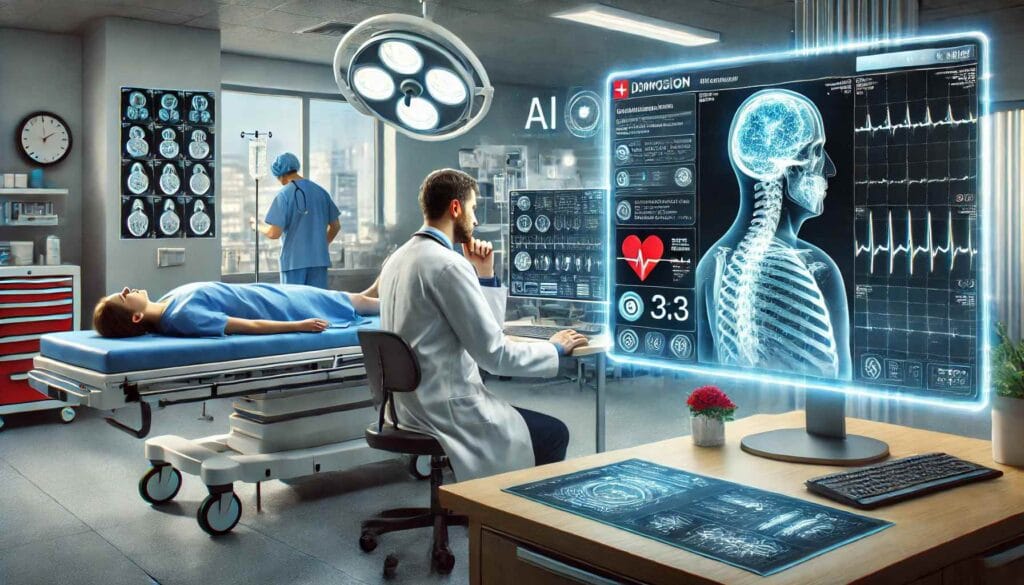The Role of AI in Diagnosing Critical and Dangerous Injuries Remotely

Artificial Intelligence (AI) is transforming the healthcare landscape, particularly in the field of trauma and emergency medicine. As medical technology advances, AI systems are increasingly being leveraged to diagnose and manage critical and dangerous injuries remotely. This article explores the potential benefits, challenges, and future outlook of AI in the remote diagnosis of severe injuries.
1. Introduction to Remote Diagnosis and AI in Healthcare
Remote diagnosis refers to the ability to assess and provide medical opinions on patients’ conditions without being physically present. This approach is particularly important in emergency situations or in areas where access to healthcare professionals is limited. AI plays a vital role in supporting healthcare professionals by providing them with quick, accurate, and data-driven insights into patient conditions.
2. AI-Powered Diagnostics for Critical Injuries
In the case of critical injuries, such as traumatic brain injuries, fractures, or severe bleeding, early detection and timely intervention can significantly impact the patient’s survival and recovery chances. AI algorithms, particularly those based on machine learning, are used to analyze medical images like CT scans, X-rays, and MRIs, which are essential for diagnosing life-threatening conditions.
AI-driven tools can identify subtle patterns in medical images that may be overlooked by human eyes, ensuring a more accurate and efficient diagnosis. These tools are trained on large datasets of medical imagery and patient records, allowing them to detect conditions such as:
- Traumatic Brain Injuries (TBI): AI algorithms can assess brain scans for signs of hemorrhage, swelling, or other abnormalities that indicate severe brain injuries.
- Fractures and Bone Injuries: AI systems can identify fractures, dislocations, and other bone-related injuries from X-rays or MRI images with great precision.
- Internal Bleeding: Machine learning models can help in the detection of internal hemorrhages, especially in the abdomen or chest, which are often hard to identify without advanced imaging.
3. The Role of AI in Triage and Decision-Making
Triage is the process of prioritizing patients based on the severity of their injuries or medical conditions. In emergency settings, AI can assist medical personnel in making quick, accurate decisions about the priority of treatment. AI algorithms can analyze patients’ vital signs, medical history, and imaging data to determine the urgency of care required. This is particularly useful in disaster situations or remote areas where healthcare resources are limited.
- Predictive Analytics: AI can predict patient outcomes by analyzing a range of factors, including vital signs, injury severity, and medical history. This allows for better decision-making, ensuring that the most critically injured patients receive immediate care.
4. Telemedicine and AI Integration
Telemedicine refers to the use of technology to provide medical care remotely. AI-powered systems are increasingly being integrated with telemedicine platforms to enhance the accuracy of remote consultations. In the case of critical injuries, telemedicine can facilitate the rapid transfer of medical images and patient data to specialists located in different parts of the world.
- Remote Monitoring: AI systems can continuously monitor a patient’s condition and alert healthcare providers to any changes that require immediate attention. For example, AI can detect signs of worsening trauma, such as a drop in blood pressure or increasing levels of inflammation.
- Real-Time Analysis: With AI, remote healthcare providers can receive real-time analysis of medical data, such as X-ray images, and provide immediate guidance or treatment recommendations.
5. Challenges and Limitations
While AI offers numerous advantages in the remote diagnosis of critical injuries, there are several challenges and limitations that must be addressed:
- Data Privacy and Security: The sharing of sensitive patient data, especially in remote settings, raises concerns about data privacy and security. Ensuring that AI systems comply with healthcare data regulations, such as HIPAA (Health Insurance Portability and Accountability Act), is essential.
- Accuracy and Reliability: Although AI systems are highly accurate, they are not infallible. There is always the risk of false positives or false negatives, which could lead to misdiagnoses. AI should be used as a support tool rather than a substitute for human judgment.
- Access to Technology: In low-resource settings, access to advanced AI technologies and medical imaging tools may be limited, hindering the full potential of remote diagnosis in these areas.
6. The Future of AI in Remote Diagnosis
As AI technology continues to evolve, its capabilities in the remote diagnosis of critical injuries are expected to expand. Future advancements may include:
- Integration with Wearables: AI could be integrated with wearable devices to monitor patients’ vital signs in real-time, providing early warning signals for medical professionals even before symptoms appear.
- Augmented Reality (AR) and AI: The combination of AR and AI could enable healthcare providers to visualize patient data in 3D during remote consultations, improving their ability to diagnose complex injuries.
- Improved Predictive Models: With the ongoing development of AI, predictive models will become more accurate, helping to determine patient outcomes and prioritize treatments with greater precision.
7. Conclusion
AI is playing an increasingly important role in the remote diagnosis of critical and dangerous injuries. By leveraging machine learning algorithms and telemedicine platforms, healthcare providers can offer faster and more accurate diagnoses, even in the most challenging circumstances. While there are still challenges to overcome, the potential benefits of AI in healthcare are immense. As technology continues to advance, the role of AI in saving lives and improving patient outcomes will only grow.
Source : Medium.com




